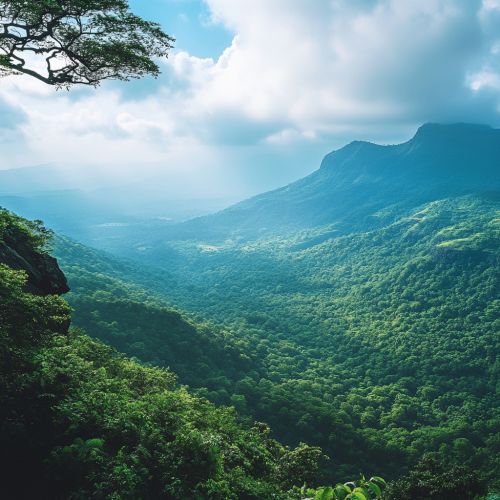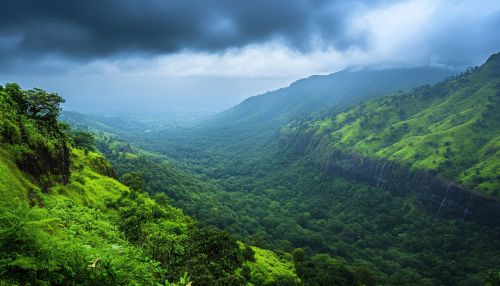Maharashtra: Difference between revisions
(Created page with "== Geography == Maharashtra is a state located in the western peninsular region of India. It is the third-largest state by area and the second-most populous state in India. The state covers an area of approximately 307,713 square kilometers and has a diverse topography that includes the Western Ghats, the Deccan Plateau, and a long coastline along the Arabian Sea. <div class='only_on_desktop image-preview'><div class='image-preview-loader'></div></div><div c...") |
No edit summary |
||
| Line 2: | Line 2: | ||
Maharashtra is a state located in the western peninsular region of India. It is the third-largest state by area and the second-most populous state in India. The state covers an area of approximately 307,713 square kilometers and has a diverse topography that includes the [[Western Ghats]], the [[Deccan Plateau]], and a long coastline along the [[Arabian Sea]]. | Maharashtra is a state located in the western peninsular region of India. It is the third-largest state by area and the second-most populous state in India. The state covers an area of approximately 307,713 square kilometers and has a diverse topography that includes the [[Western Ghats]], the [[Deccan Plateau]], and a long coastline along the [[Arabian Sea]]. | ||
[[Image:Detail-98213.jpg|thumb|center|Scenic landscape of Maharashtra featuring the Western Ghats and lush greenery.|class=only_on_mobile]] | |||
[[Image:Detail-98214.jpg|thumb|center|Scenic landscape of Maharashtra featuring the Western Ghats and lush greenery.|class=only_on_desktop]] | |||
The Western Ghats, a UNESCO World Heritage Site, run parallel to the western coast and are known for their rich biodiversity. The Deccan Plateau, which occupies most of the state, is characterized by its volcanic basalt rock formations. The coastal region, known as the Konkan, is marked by sandy beaches, estuaries, and lush greenery. | The Western Ghats, a UNESCO World Heritage Site, run parallel to the western coast and are known for their rich biodiversity. The Deccan Plateau, which occupies most of the state, is characterized by its volcanic basalt rock formations. The coastal region, known as the Konkan, is marked by sandy beaches, estuaries, and lush greenery. | ||
Latest revision as of 19:44, 8 October 2024
Geography
Maharashtra is a state located in the western peninsular region of India. It is the third-largest state by area and the second-most populous state in India. The state covers an area of approximately 307,713 square kilometers and has a diverse topography that includes the Western Ghats, the Deccan Plateau, and a long coastline along the Arabian Sea.


The Western Ghats, a UNESCO World Heritage Site, run parallel to the western coast and are known for their rich biodiversity. The Deccan Plateau, which occupies most of the state, is characterized by its volcanic basalt rock formations. The coastal region, known as the Konkan, is marked by sandy beaches, estuaries, and lush greenery.
History
Maharashtra has a rich historical background that dates back to ancient times. The region was part of the Maurya Empire and later the Satavahana dynasty. During the medieval period, it was ruled by various dynasties, including the Chalukyas, Rashtrakutas, and Yadavas.
The state gained prominence under the rule of the Maratha Empire in the 17th and 18th centuries. Founded by Shivaji, the Maratha Empire played a crucial role in resisting Mughal expansion in India. The Peshwas, who were the prime ministers of the Maratha Empire, further expanded the territory and influence of Maharashtra.
Economy
Maharashtra is one of the most industrialized states in India and contributes significantly to the country's economy. The state has a diverse economic base that includes agriculture, manufacturing, and services.
Agriculture
Agriculture remains a vital part of Maharashtra's economy, with major crops including sugarcane, cotton, soybean, and rice. The state is also a leading producer of grapes, mangoes, and oranges. The irrigation infrastructure in the state supports the cultivation of these crops, although some regions still rely on monsoon rains.
Industry
Maharashtra is a hub for various industries, including automobile manufacturing, pharmaceuticals, information technology, and textiles. The state capital, Mumbai, is the financial capital of India and hosts the headquarters of numerous multinational corporations and financial institutions.
Services
The services sector in Maharashtra is robust, with significant contributions from banking, insurance, real estate, and tourism. The state is also a major center for the Bollywood film industry, which produces a large number of films annually.
Demographics
Maharashtra has a diverse population with a mix of various ethnic groups and communities. According to the 2011 Census, the state has a population of approximately 112 million people. The official language is Marathi, which is spoken by the majority of the population.
The state is also home to significant communities of Gujaratis, Kannadigas, Telugus, and North Indians. The religious composition includes Hindus, Muslims, Buddhists, Christians, and Jains.
Culture
Maharashtra has a rich cultural heritage that includes literature, music, dance, and festivals. The state is known for its classical music traditions, including the Hindustani and Carnatic styles. Lavani and Tamasha are popular folk dance forms that originated in Maharashtra.
Festivals
The state celebrates a variety of festivals with great enthusiasm. Ganesh Chaturthi is one of the most important festivals, marked by elaborate processions and celebrations. Other major festivals include Diwali, Holi, Eid al-Fitr, and Christmas.
Cuisine
Maharashtrian cuisine is diverse and includes a range of vegetarian and non-vegetarian dishes. Some of the popular dishes include Pav Bhaji, Vada Pav, Puran Poli, and Bhakri. The cuisine varies by region, with coastal areas favoring seafood and inland areas focusing on grains and legumes.
Education
Maharashtra has a well-developed education system with numerous institutions of higher learning. The state is home to prestigious universities such as the University of Mumbai, Savitribai Phule Pune University, and Dr. Babasaheb Ambedkar Marathwada University.
The state also has several renowned engineering and medical colleges, including the Indian Institute of Technology Bombay and the Grant Medical College. The literacy rate in Maharashtra is higher than the national average, reflecting the state's emphasis on education.
Infrastructure
Maharashtra boasts a well-developed infrastructure that supports its economic activities. The state has an extensive network of roads, railways, and airports.
Transportation
The Mumbai Suburban Railway is one of the busiest commuter rail systems in the world. The state also has several major ports, including the Jawaharlal Nehru Port, which is one of the largest container ports in India. The Chhatrapati Shivaji Maharaj International Airport in Mumbai is a major international gateway.
Energy
Maharashtra is a leading producer of electricity in India, with a mix of thermal, hydroelectric, and renewable energy sources. The state has several major power plants, including the Tarapur Atomic Power Station and the Koyna Hydroelectric Project.
Governance
Maharashtra is governed by a parliamentary system with a bicameral legislature, consisting of the Maharashtra Legislative Assembly and the Maharashtra Legislative Council. The Governor of Maharashtra is the ceremonial head of the state, while the Chief Minister is the head of the government.
The state is divided into 36 districts, each administered by a District Collector. The urban areas are governed by municipal corporations, while the rural areas are managed by Panchayati Raj institutions.
